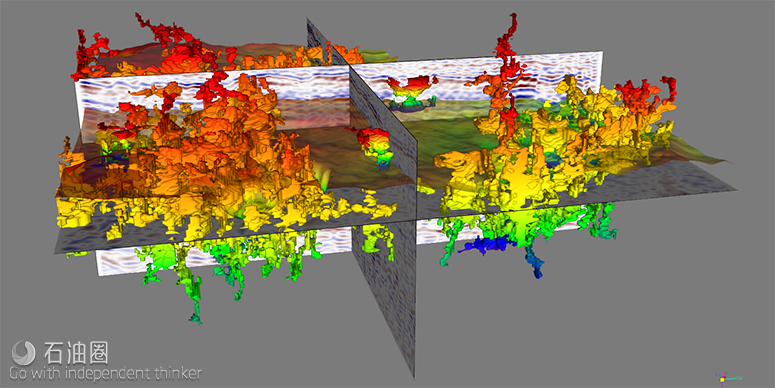EarthStudy 360 as a Tool for Stress and Fracture Detection
EarthStudy 360 uses both directional and reflection angle gathers to image and detect subsurface local heterogeneities such as small faults and fne fractures. Diffraction weighted stacks applied to directional angle gathers enable high-resolution imaging of the fracture system within the reservoir. Azimuthal-dependent residual moveouts (VVAZ) and amplitude variations (AVAZ), which can be automatically extracted from the full-azimuth reflection angle gathers, provide accurate information about the orientation and density of fracture systems.
Orthorhombic Model Support
Running the EarthStudy 360 Imager with orthorhombic layer parameters allows users to fully validate the accuracy of their fracture analysis and improve imaging, in conventional and unconventional plays. This adds another level of confidence in the results, and results in better drilling decisions.
Illumination for Seismic Data Mining
The EarthStudy 360 Illuminator is an advanced seismic data mining tool that provides a previously unattainable breadth of knowledge about ray propagation in complex areas.
The Illuminator uses an enhanced, interactive ray tracing technology that both quantifes and qualifes the relationship between the surface acquisition geometry and the subsurface angles in targeted areas. Launched from the Paradigm SeisEarth® or GeoDepth® 3D Canvas, input for the Illuminator includes isotropic/anisotropic velocity models and optionally, data acquisition geometry. Interpreters can generate ray attributes, illumination and reliability maps to gain knowledge about the quality and integrity of the seismic image. A user who wants to know more about why certain areas have low reliability, has access to an extensive set of tools which deliver that knowledge. The results are displayed in a clear visual manner, simplifying even the most complex set of imaging characteristics.
Features
•Support for isotropic and anisotropic models (VTI, TTI and Orthorhombic)
•Customizable to image specific exploration or development challenges, such as velocity determination and amplitude inversion
•Directivity-driven: Can run in preferred directions with respect to given background directivities (dip and azimuth)
•Beam steering: Performs tapered local slant stack, and migrates only energetic events
•Imaging with local slant stack events, providing significant multiple suppression
•A collection of all the display tools that enable visualization of EarthStudy 360 gathers: Velocity Navigator, 3D Canvas and 3D Gather Visualizer
•Generates optimal data for tomographic velocity updates and amplitude analysis
•Includes Paradigm 2D/3D CRAM® for generating conventional reflection angle gathers with no azimuth dependency
•Support for Ocean Bottom Cable acquisition data
•Support for Q Compensation, improving resolution, amplitude balancing and image quality by compensating for dissipation and attenuation effects
The Paradigm Advantage
•Full-azimuth angle domain imaging and analysis maximize knowledge from seismic data.
•Optimizes ROI for deep water, unconventional shale resource plays and fractured carbonate reservoirs.
•Extracts unprecedented value from all modern and legacy seismic data acquisitions, notably those with wide and rich azimuth and long offset.
•Delivers highly accurate isotropic/anisotropic velocity models, especially in complex subsurface areas.
•Delivers high-resolution information about principal reservoir properties.
Case Study
Offshore – Narrow Azimuth and irregular water bottom
Location: Offshore Australia
Challenge
Limited narrow azimuth offshore acquisition
Imaging in the presence of a highly irregular water bottom.
Dry hole drilled based on current depth imaging technology
Oil company needed to resolve current interpretation.
Solution
Used Paradigm technologies to generate a significantly revised velocity model with a more precise handling of irregular water bottom
Used EarthStudy 360 full azimuth imaging to enhance the specular (continuous) energy in the deeper reservoir section
Result
EarthStudy 360 images explained the dry well, exhibiting a compelling revised structural interpretation. Other contractors still unable to reproduce Paradigm’s depth image with EarthStudy 360
Deep Water and Wide Azimuth
Location: Deep water
GOM Company was planning a deep water GOM well and wanted a comprehensive imaging perspective to support a drilling decision based on Reverse Time Migration.
Challenge
Drilling objective approximately 30,000 feet
Sub salt imaging in the presence of a highly irregular and multiple salt structures
Anisotropic (VTI/TTI) shale overburden
Oil company needed a better understanding of a subsalt interpretation.
Solution
Used EarthStudy 360 imaging to confirm oil companies current velocity model and to generate optimum image with unique “specular” weighting capability
Used EarthStudy 360 full azimuth illumination to further understand illumination issues related to acquisition and salt-velocity model
Result
EarthStudy 360 images revealed an alternative interpretation perspective of subsalt areas which were subsequently invoked in the post mortem analysis Paradigm results held up with respect to Reverse Time Migration Images.
Jerzy Trela, COO Geofzyka Torun: PolandWith EarthStudy 360 we are able to deliver a much better product compared to standard 3D imaging. Reliable attributes estimated using EarthStudy 360 can help define sweet spots for unconventional prospects, as well as provide effective support to decisions about horizontal drilling and hydraulic fracturing. Together, these significantly reduce prospect uncertainty. Following our comprehensive and successful evaluation, in which we ran full-azimuth anisotropic imaging on the first 3D shale gas seismic survey in Poland, Geofzyka Torun now plans to process the next shale gas seismic project with support from Paradigm.


 石油圈
石油圈
